Report on Legal Concepts: Representation, Dismissal, and Duties
VerifiedAdded on 2021/02/18
|12
|3665
|57
Report
AI Summary
This report provides a comprehensive analysis of several key legal concepts. It begins by defining representation and differentiating it from terms of a contract, using a case study to illustrate the principles of contract law. The report then outlines the grounds for unfair dismissal from employmen...
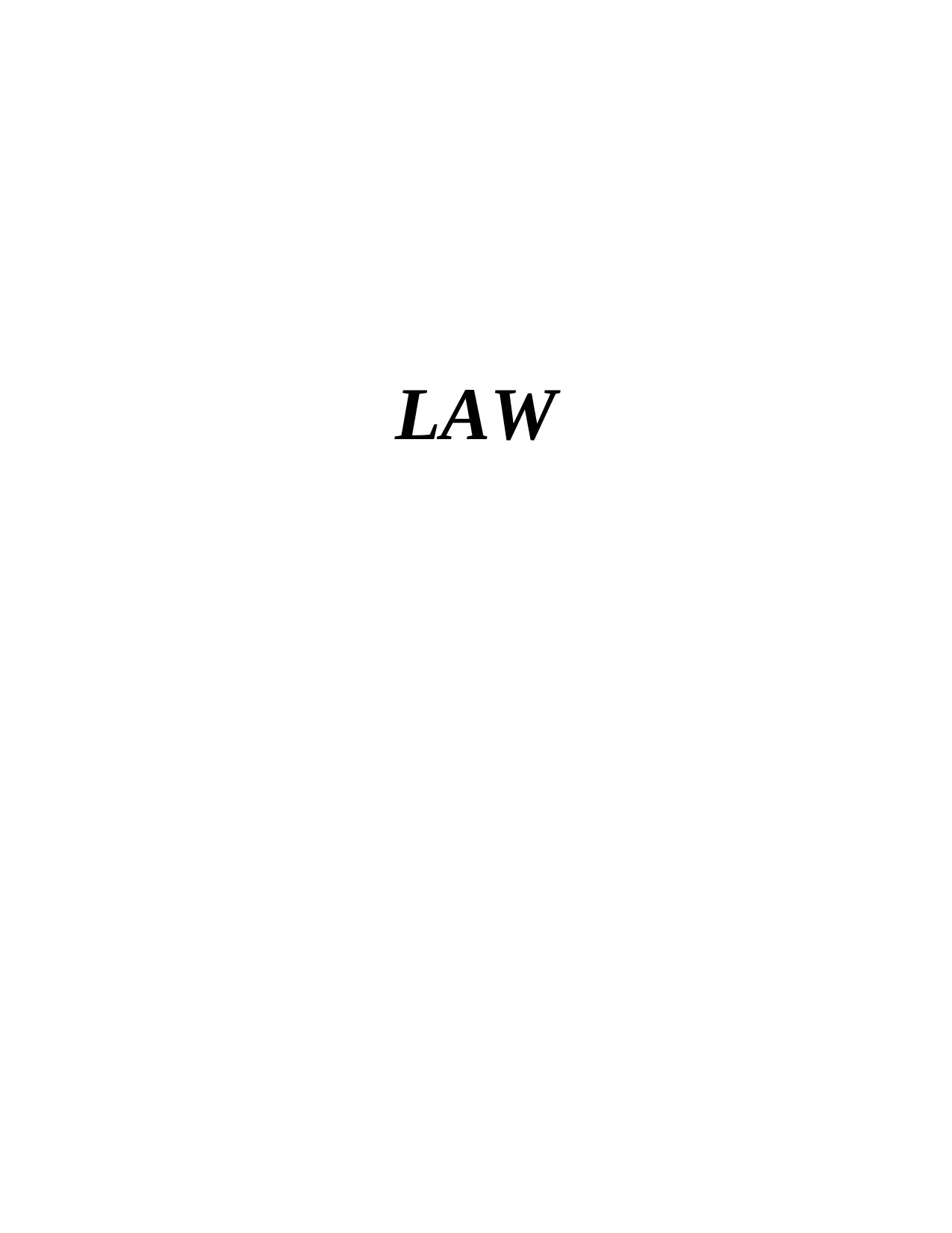
LAW
Paraphrase This Document
Need a fresh take? Get an instant paraphrase of this document with our AI Paraphraser

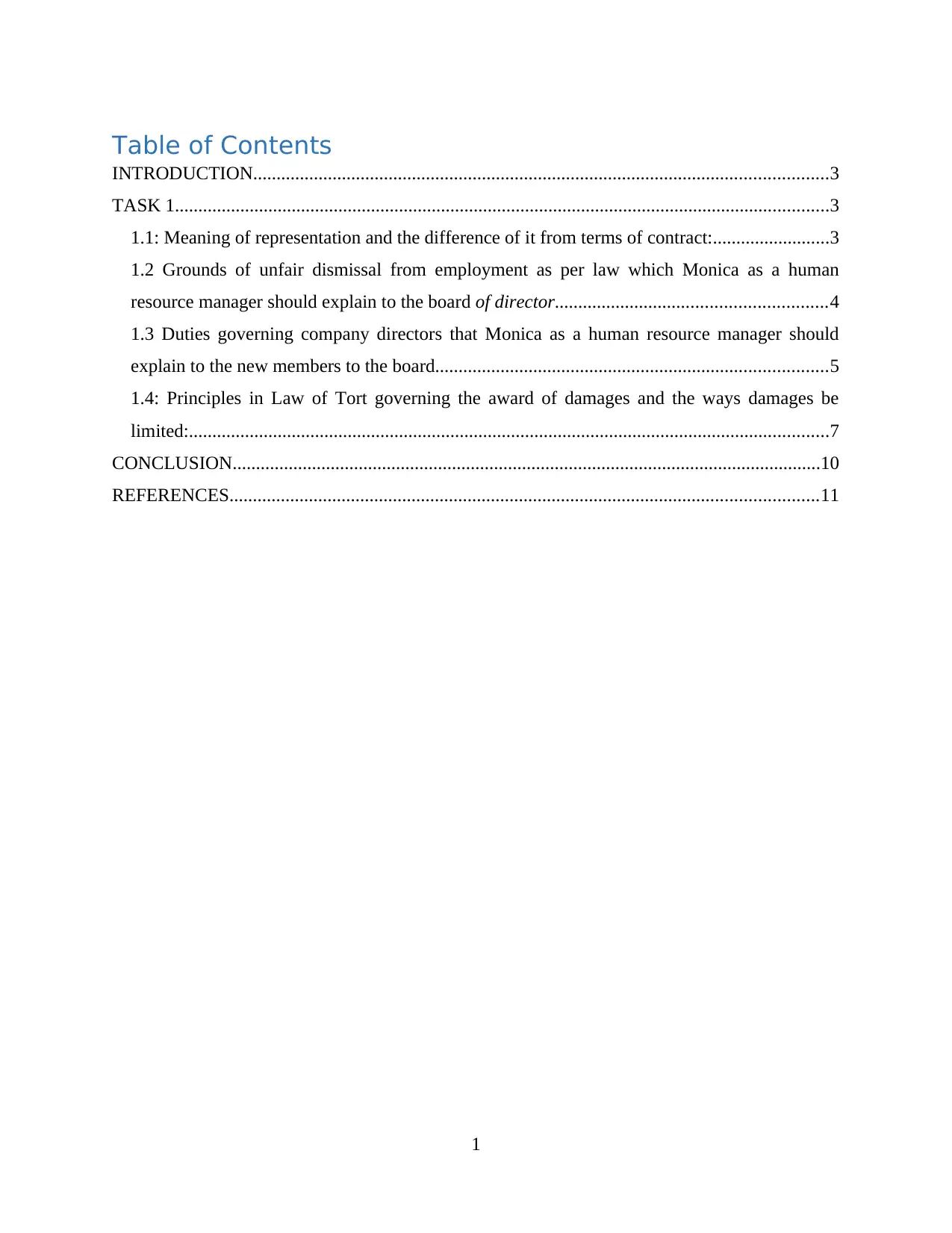
Table of Contents
INTRODUCTION...........................................................................................................................3
TASK 1............................................................................................................................................3
1.1: Meaning of representation and the difference of it from terms of contract:.........................3
1.2 Grounds of unfair dismissal from employment as per law which Monica as a human
resource manager should explain to the board of director..........................................................4
1.3 Duties governing company directors that Monica as a human resource manager should
explain to the new members to the board....................................................................................5
1.4: Principles in Law of Tort governing the award of damages and the ways damages be
limited:.........................................................................................................................................7
CONCLUSION..............................................................................................................................10
REFERENCES..............................................................................................................................11
1
INTRODUCTION...........................................................................................................................3
TASK 1............................................................................................................................................3
1.1: Meaning of representation and the difference of it from terms of contract:.........................3
1.2 Grounds of unfair dismissal from employment as per law which Monica as a human
resource manager should explain to the board of director..........................................................4
1.3 Duties governing company directors that Monica as a human resource manager should
explain to the new members to the board....................................................................................5
1.4: Principles in Law of Tort governing the award of damages and the ways damages be
limited:.........................................................................................................................................7
CONCLUSION..............................................................................................................................10
REFERENCES..............................................................................................................................11
1
⊘ This is a preview!⊘
Do you want full access?
Subscribe today to unlock all pages.

Trusted by 1+ million students worldwide
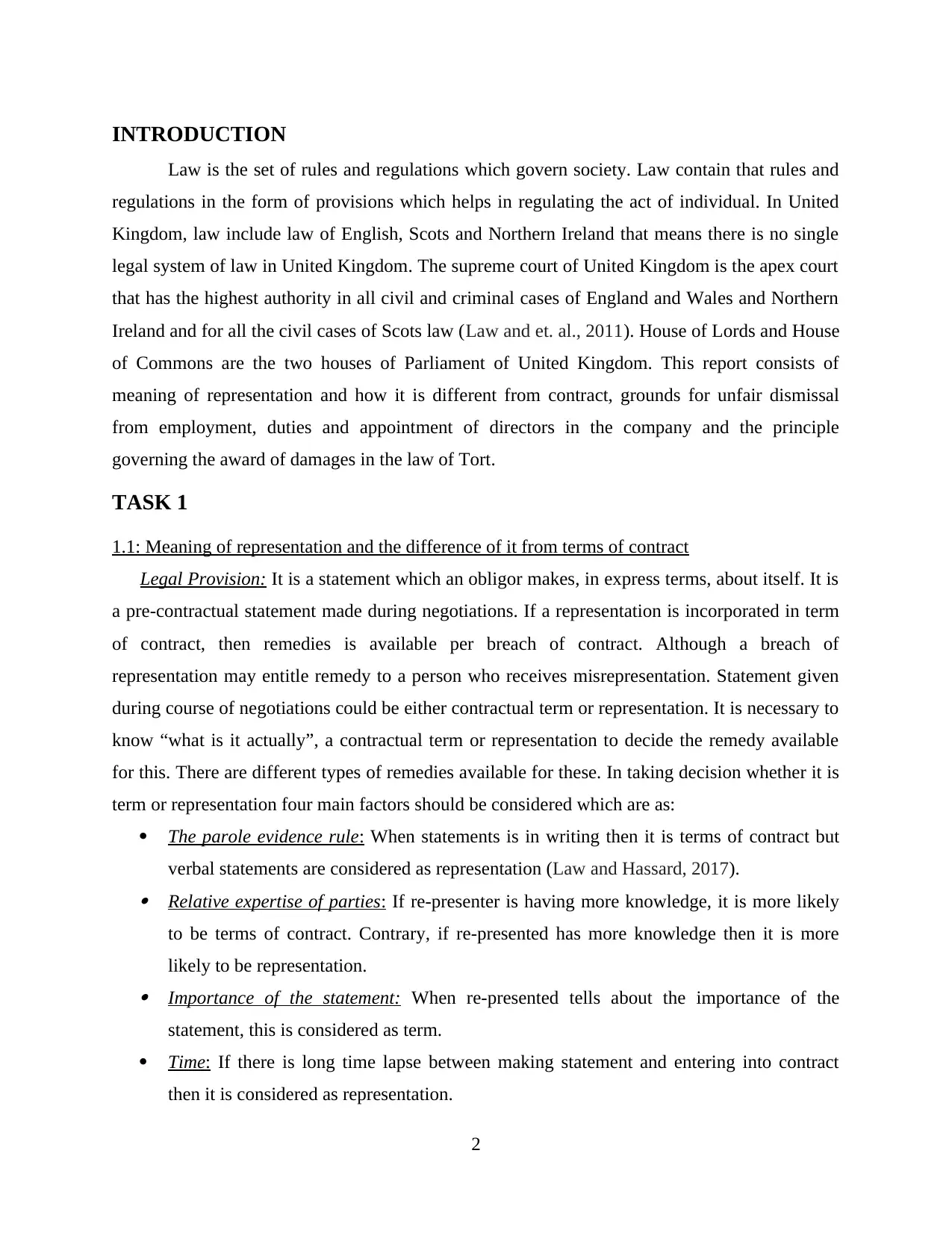
INTRODUCTION
Law is the set of rules and regulations which govern society. Law contain that rules and
regulations in the form of provisions which helps in regulating the act of individual. In United
Kingdom, law include law of English, Scots and Northern Ireland that means there is no single
legal system of law in United Kingdom. The supreme court of United Kingdom is the apex court
that has the highest authority in all civil and criminal cases of England and Wales and Northern
Ireland and for all the civil cases of Scots law (Law and et. al., 2011). House of Lords and House
of Commons are the two houses of Parliament of United Kingdom. This report consists of
meaning of representation and how it is different from contract, grounds for unfair dismissal
from employment, duties and appointment of directors in the company and the principle
governing the award of damages in the law of Tort.
TASK 1
1.1: Meaning of representation and the difference of it from terms of contract
Legal Provision: It is a statement which an obligor makes, in express terms, about itself. It is
a pre-contractual statement made during negotiations. If a representation is incorporated in term
of contract, then remedies is available per breach of contract. Although a breach of
representation may entitle remedy to a person who receives misrepresentation. Statement given
during course of negotiations could be either contractual term or representation. It is necessary to
know “what is it actually”, a contractual term or representation to decide the remedy available
for this. There are different types of remedies available for these. In taking decision whether it is
term or representation four main factors should be considered which are as:
The parole evidence rule: When statements is in writing then it is terms of contract but
verbal statements are considered as representation (Law and Hassard, 2017). Relative expertise of parties: If re-presenter is having more knowledge, it is more likely
to be terms of contract. Contrary, if re-presented has more knowledge then it is more
likely to be representation. Importance of the statement: When re-presented tells about the importance of the
statement, this is considered as term.
Time: If there is long time lapse between making statement and entering into contract
then it is considered as representation.
2
Law is the set of rules and regulations which govern society. Law contain that rules and
regulations in the form of provisions which helps in regulating the act of individual. In United
Kingdom, law include law of English, Scots and Northern Ireland that means there is no single
legal system of law in United Kingdom. The supreme court of United Kingdom is the apex court
that has the highest authority in all civil and criminal cases of England and Wales and Northern
Ireland and for all the civil cases of Scots law (Law and et. al., 2011). House of Lords and House
of Commons are the two houses of Parliament of United Kingdom. This report consists of
meaning of representation and how it is different from contract, grounds for unfair dismissal
from employment, duties and appointment of directors in the company and the principle
governing the award of damages in the law of Tort.
TASK 1
1.1: Meaning of representation and the difference of it from terms of contract
Legal Provision: It is a statement which an obligor makes, in express terms, about itself. It is
a pre-contractual statement made during negotiations. If a representation is incorporated in term
of contract, then remedies is available per breach of contract. Although a breach of
representation may entitle remedy to a person who receives misrepresentation. Statement given
during course of negotiations could be either contractual term or representation. It is necessary to
know “what is it actually”, a contractual term or representation to decide the remedy available
for this. There are different types of remedies available for these. In taking decision whether it is
term or representation four main factors should be considered which are as:
The parole evidence rule: When statements is in writing then it is terms of contract but
verbal statements are considered as representation (Law and Hassard, 2017). Relative expertise of parties: If re-presenter is having more knowledge, it is more likely
to be terms of contract. Contrary, if re-presented has more knowledge then it is more
likely to be representation. Importance of the statement: When re-presented tells about the importance of the
statement, this is considered as term.
Time: If there is long time lapse between making statement and entering into contract
then it is considered as representation.
2
Paraphrase This Document
Need a fresh take? Get an instant paraphrase of this document with our AI Paraphraser
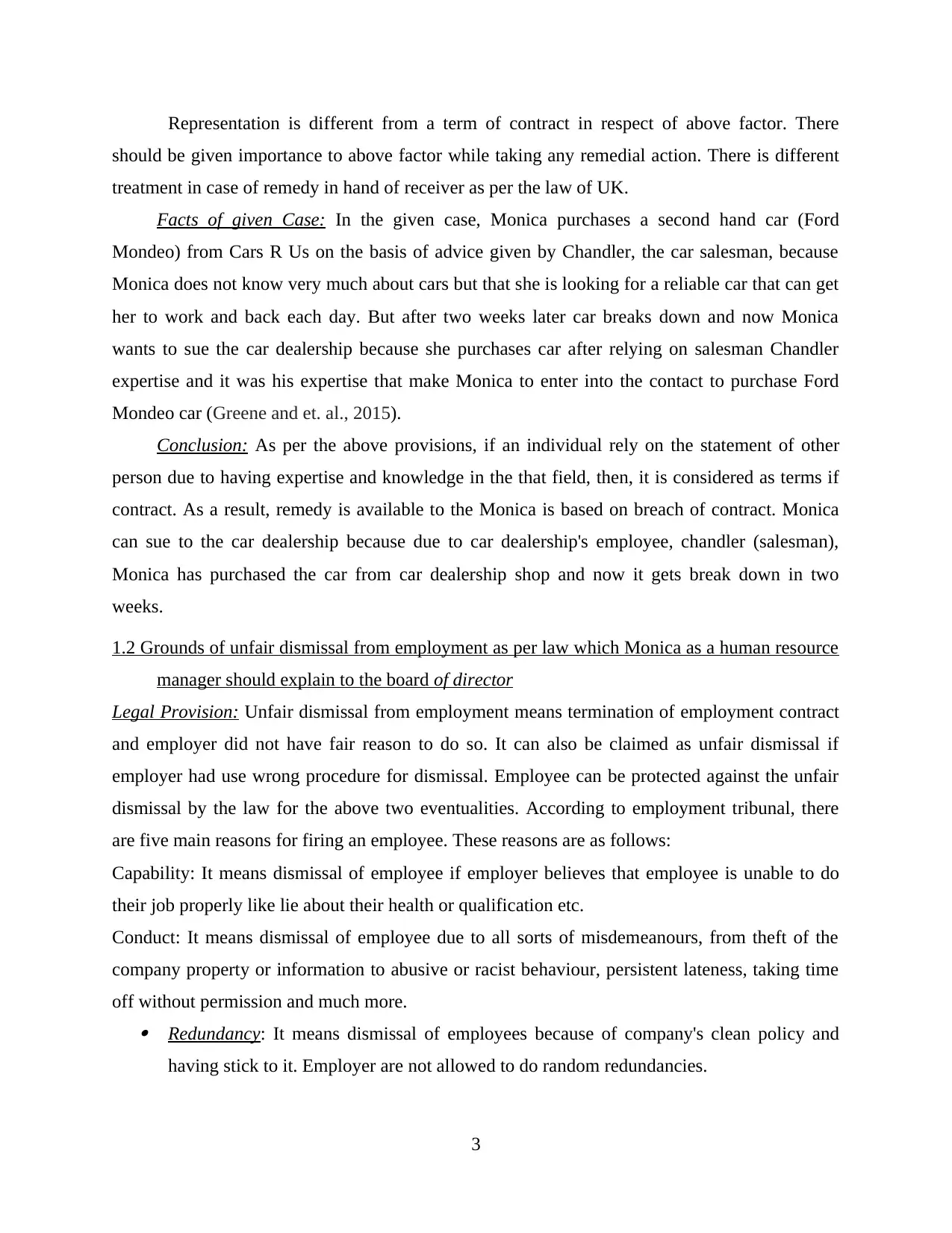
Representation is different from a term of contract in respect of above factor. There
should be given importance to above factor while taking any remedial action. There is different
treatment in case of remedy in hand of receiver as per the law of UK.
Facts of given Case: In the given case, Monica purchases a second hand car (Ford
Mondeo) from Cars R Us on the basis of advice given by Chandler, the car salesman, because
Monica does not know very much about cars but that she is looking for a reliable car that can get
her to work and back each day. But after two weeks later car breaks down and now Monica
wants to sue the car dealership because she purchases car after relying on salesman Chandler
expertise and it was his expertise that make Monica to enter into the contact to purchase Ford
Mondeo car (Greene and et. al., 2015).
Conclusion: As per the above provisions, if an individual rely on the statement of other
person due to having expertise and knowledge in the that field, then, it is considered as terms if
contract. As a result, remedy is available to the Monica is based on breach of contract. Monica
can sue to the car dealership because due to car dealership's employee, chandler (salesman),
Monica has purchased the car from car dealership shop and now it gets break down in two
weeks.
1.2 Grounds of unfair dismissal from employment as per law which Monica as a human resource
manager should explain to the board of director
Legal Provision: Unfair dismissal from employment means termination of employment contract
and employer did not have fair reason to do so. It can also be claimed as unfair dismissal if
employer had use wrong procedure for dismissal. Employee can be protected against the unfair
dismissal by the law for the above two eventualities. According to employment tribunal, there
are five main reasons for firing an employee. These reasons are as follows:
Capability: It means dismissal of employee if employer believes that employee is unable to do
their job properly like lie about their health or qualification etc.
Conduct: It means dismissal of employee due to all sorts of misdemeanours, from theft of the
company property or information to abusive or racist behaviour, persistent lateness, taking time
off without permission and much more. Redundancy: It means dismissal of employees because of company's clean policy and
having stick to it. Employer are not allowed to do random redundancies.
3
should be given importance to above factor while taking any remedial action. There is different
treatment in case of remedy in hand of receiver as per the law of UK.
Facts of given Case: In the given case, Monica purchases a second hand car (Ford
Mondeo) from Cars R Us on the basis of advice given by Chandler, the car salesman, because
Monica does not know very much about cars but that she is looking for a reliable car that can get
her to work and back each day. But after two weeks later car breaks down and now Monica
wants to sue the car dealership because she purchases car after relying on salesman Chandler
expertise and it was his expertise that make Monica to enter into the contact to purchase Ford
Mondeo car (Greene and et. al., 2015).
Conclusion: As per the above provisions, if an individual rely on the statement of other
person due to having expertise and knowledge in the that field, then, it is considered as terms if
contract. As a result, remedy is available to the Monica is based on breach of contract. Monica
can sue to the car dealership because due to car dealership's employee, chandler (salesman),
Monica has purchased the car from car dealership shop and now it gets break down in two
weeks.
1.2 Grounds of unfair dismissal from employment as per law which Monica as a human resource
manager should explain to the board of director
Legal Provision: Unfair dismissal from employment means termination of employment contract
and employer did not have fair reason to do so. It can also be claimed as unfair dismissal if
employer had use wrong procedure for dismissal. Employee can be protected against the unfair
dismissal by the law for the above two eventualities. According to employment tribunal, there
are five main reasons for firing an employee. These reasons are as follows:
Capability: It means dismissal of employee if employer believes that employee is unable to do
their job properly like lie about their health or qualification etc.
Conduct: It means dismissal of employee due to all sorts of misdemeanours, from theft of the
company property or information to abusive or racist behaviour, persistent lateness, taking time
off without permission and much more. Redundancy: It means dismissal of employees because of company's clean policy and
having stick to it. Employer are not allowed to do random redundancies.
3
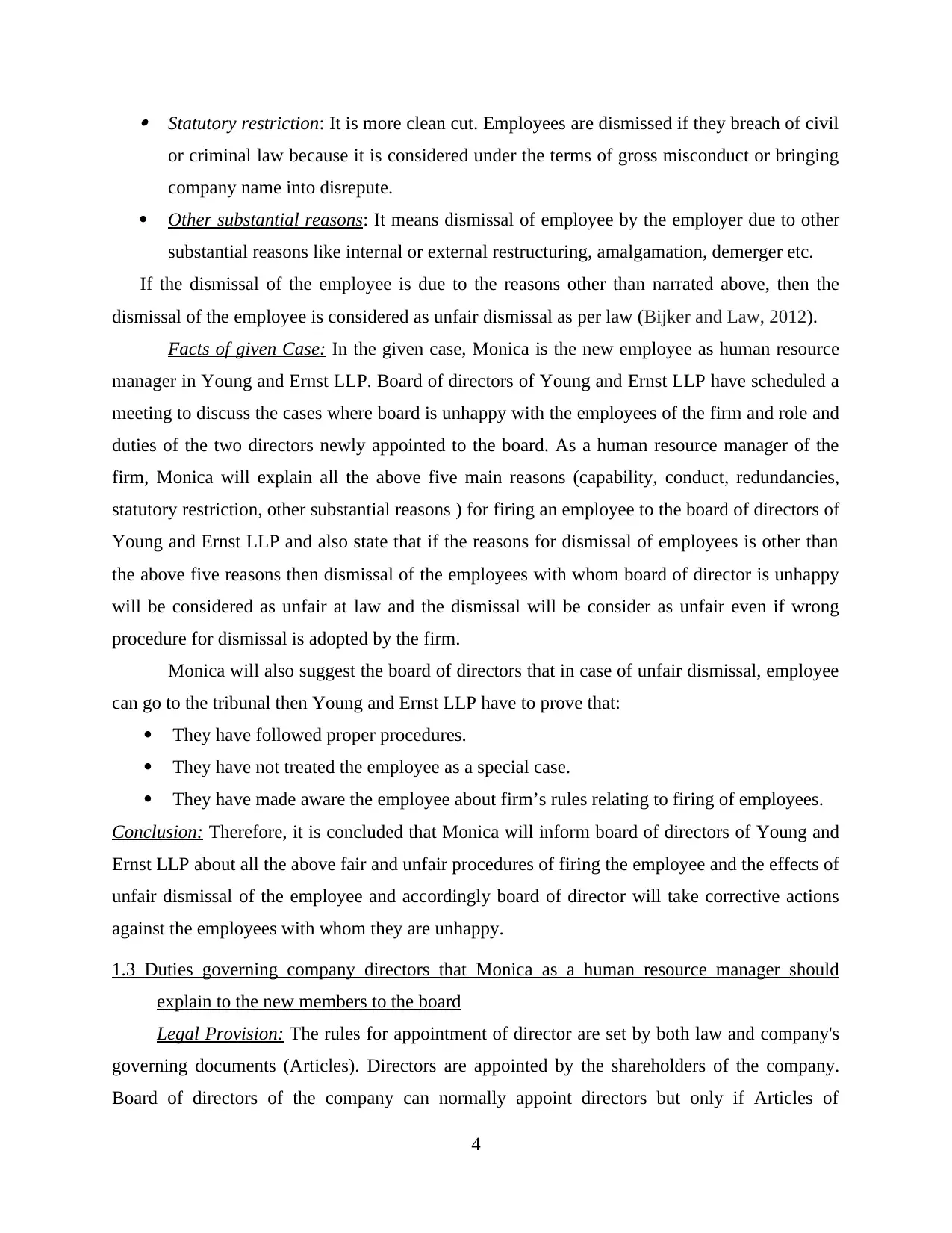
Statutory restriction: It is more clean cut. Employees are dismissed if they breach of civil
or criminal law because it is considered under the terms of gross misconduct or bringing
company name into disrepute.
Other substantial reasons: It means dismissal of employee by the employer due to other
substantial reasons like internal or external restructuring, amalgamation, demerger etc.
If the dismissal of the employee is due to the reasons other than narrated above, then the
dismissal of the employee is considered as unfair dismissal as per law (Bijker and Law, 2012).
Facts of given Case: In the given case, Monica is the new employee as human resource
manager in Young and Ernst LLP. Board of directors of Young and Ernst LLP have scheduled a
meeting to discuss the cases where board is unhappy with the employees of the firm and role and
duties of the two directors newly appointed to the board. As a human resource manager of the
firm, Monica will explain all the above five main reasons (capability, conduct, redundancies,
statutory restriction, other substantial reasons ) for firing an employee to the board of directors of
Young and Ernst LLP and also state that if the reasons for dismissal of employees is other than
the above five reasons then dismissal of the employees with whom board of director is unhappy
will be considered as unfair at law and the dismissal will be consider as unfair even if wrong
procedure for dismissal is adopted by the firm.
Monica will also suggest the board of directors that in case of unfair dismissal, employee
can go to the tribunal then Young and Ernst LLP have to prove that:
They have followed proper procedures.
They have not treated the employee as a special case.
They have made aware the employee about firm’s rules relating to firing of employees.
Conclusion: Therefore, it is concluded that Monica will inform board of directors of Young and
Ernst LLP about all the above fair and unfair procedures of firing the employee and the effects of
unfair dismissal of the employee and accordingly board of director will take corrective actions
against the employees with whom they are unhappy.
1.3 Duties governing company directors that Monica as a human resource manager should
explain to the new members to the board
Legal Provision: The rules for appointment of director are set by both law and company's
governing documents (Articles). Directors are appointed by the shareholders of the company.
Board of directors of the company can normally appoint directors but only if Articles of
4
or criminal law because it is considered under the terms of gross misconduct or bringing
company name into disrepute.
Other substantial reasons: It means dismissal of employee by the employer due to other
substantial reasons like internal or external restructuring, amalgamation, demerger etc.
If the dismissal of the employee is due to the reasons other than narrated above, then the
dismissal of the employee is considered as unfair dismissal as per law (Bijker and Law, 2012).
Facts of given Case: In the given case, Monica is the new employee as human resource
manager in Young and Ernst LLP. Board of directors of Young and Ernst LLP have scheduled a
meeting to discuss the cases where board is unhappy with the employees of the firm and role and
duties of the two directors newly appointed to the board. As a human resource manager of the
firm, Monica will explain all the above five main reasons (capability, conduct, redundancies,
statutory restriction, other substantial reasons ) for firing an employee to the board of directors of
Young and Ernst LLP and also state that if the reasons for dismissal of employees is other than
the above five reasons then dismissal of the employees with whom board of director is unhappy
will be considered as unfair at law and the dismissal will be consider as unfair even if wrong
procedure for dismissal is adopted by the firm.
Monica will also suggest the board of directors that in case of unfair dismissal, employee
can go to the tribunal then Young and Ernst LLP have to prove that:
They have followed proper procedures.
They have not treated the employee as a special case.
They have made aware the employee about firm’s rules relating to firing of employees.
Conclusion: Therefore, it is concluded that Monica will inform board of directors of Young and
Ernst LLP about all the above fair and unfair procedures of firing the employee and the effects of
unfair dismissal of the employee and accordingly board of director will take corrective actions
against the employees with whom they are unhappy.
1.3 Duties governing company directors that Monica as a human resource manager should
explain to the new members to the board
Legal Provision: The rules for appointment of director are set by both law and company's
governing documents (Articles). Directors are appointed by the shareholders of the company.
Board of directors of the company can normally appoint directors but only if Articles of
4
⊘ This is a preview!⊘
Do you want full access?
Subscribe today to unlock all pages.

Trusted by 1+ million students worldwide
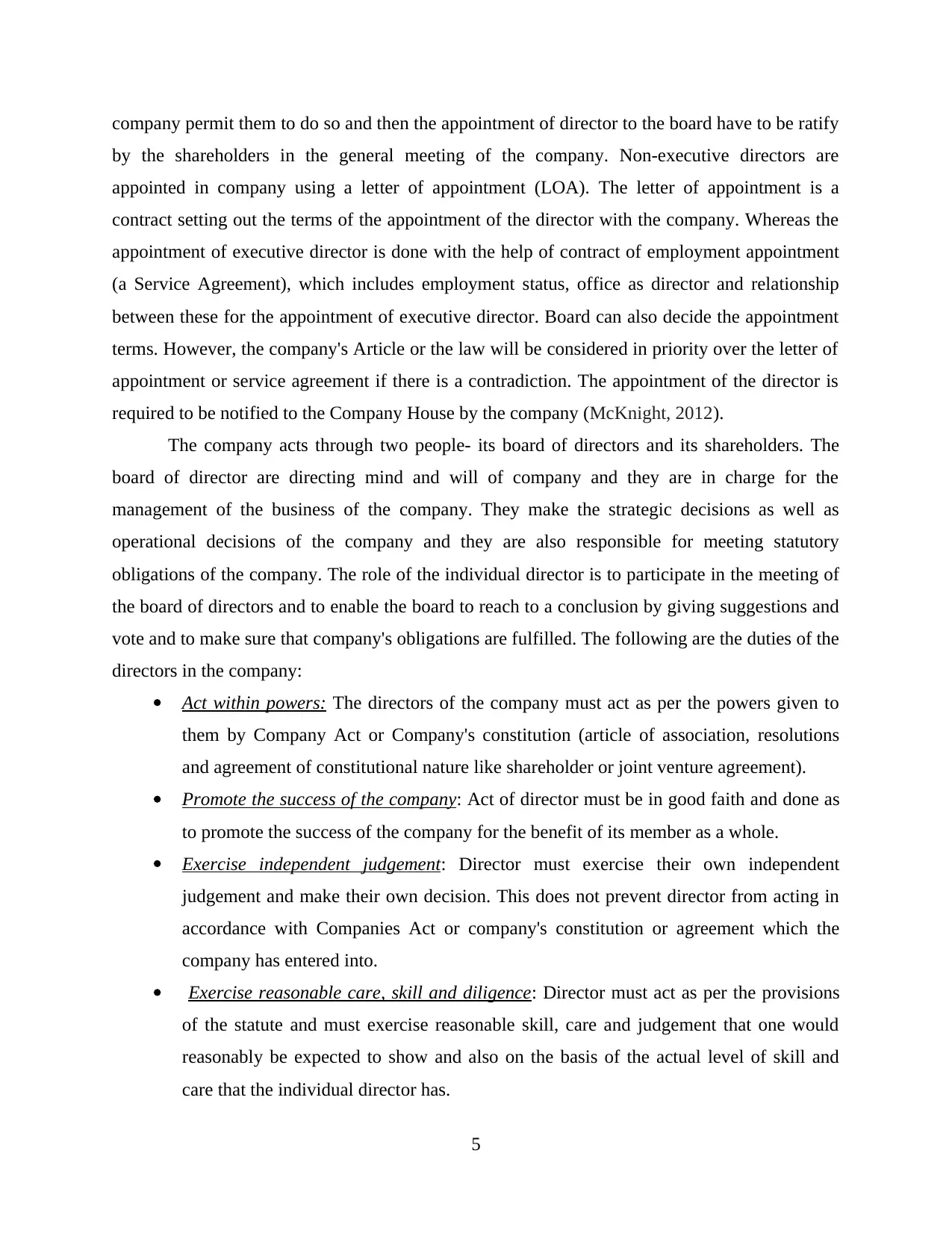
company permit them to do so and then the appointment of director to the board have to be ratify
by the shareholders in the general meeting of the company. Non-executive directors are
appointed in company using a letter of appointment (LOA). The letter of appointment is a
contract setting out the terms of the appointment of the director with the company. Whereas the
appointment of executive director is done with the help of contract of employment appointment
(a Service Agreement), which includes employment status, office as director and relationship
between these for the appointment of executive director. Board can also decide the appointment
terms. However, the company's Article or the law will be considered in priority over the letter of
appointment or service agreement if there is a contradiction. The appointment of the director is
required to be notified to the Company House by the company (McKnight, 2012).
The company acts through two people- its board of directors and its shareholders. The
board of director are directing mind and will of company and they are in charge for the
management of the business of the company. They make the strategic decisions as well as
operational decisions of the company and they are also responsible for meeting statutory
obligations of the company. The role of the individual director is to participate in the meeting of
the board of directors and to enable the board to reach to a conclusion by giving suggestions and
vote and to make sure that company's obligations are fulfilled. The following are the duties of the
directors in the company:
Act within powers: The directors of the company must act as per the powers given to
them by Company Act or Company's constitution (article of association, resolutions
and agreement of constitutional nature like shareholder or joint venture agreement).
Promote the success of the company: Act of director must be in good faith and done as
to promote the success of the company for the benefit of its member as a whole.
Exercise independent judgement: Director must exercise their own independent
judgement and make their own decision. This does not prevent director from acting in
accordance with Companies Act or company's constitution or agreement which the
company has entered into.
Exercise reasonable care, skill and diligence: Director must act as per the provisions
of the statute and must exercise reasonable skill, care and judgement that one would
reasonably be expected to show and also on the basis of the actual level of skill and
care that the individual director has.
5
by the shareholders in the general meeting of the company. Non-executive directors are
appointed in company using a letter of appointment (LOA). The letter of appointment is a
contract setting out the terms of the appointment of the director with the company. Whereas the
appointment of executive director is done with the help of contract of employment appointment
(a Service Agreement), which includes employment status, office as director and relationship
between these for the appointment of executive director. Board can also decide the appointment
terms. However, the company's Article or the law will be considered in priority over the letter of
appointment or service agreement if there is a contradiction. The appointment of the director is
required to be notified to the Company House by the company (McKnight, 2012).
The company acts through two people- its board of directors and its shareholders. The
board of director are directing mind and will of company and they are in charge for the
management of the business of the company. They make the strategic decisions as well as
operational decisions of the company and they are also responsible for meeting statutory
obligations of the company. The role of the individual director is to participate in the meeting of
the board of directors and to enable the board to reach to a conclusion by giving suggestions and
vote and to make sure that company's obligations are fulfilled. The following are the duties of the
directors in the company:
Act within powers: The directors of the company must act as per the powers given to
them by Company Act or Company's constitution (article of association, resolutions
and agreement of constitutional nature like shareholder or joint venture agreement).
Promote the success of the company: Act of director must be in good faith and done as
to promote the success of the company for the benefit of its member as a whole.
Exercise independent judgement: Director must exercise their own independent
judgement and make their own decision. This does not prevent director from acting in
accordance with Companies Act or company's constitution or agreement which the
company has entered into.
Exercise reasonable care, skill and diligence: Director must act as per the provisions
of the statute and must exercise reasonable skill, care and judgement that one would
reasonably be expected to show and also on the basis of the actual level of skill and
care that the individual director has.
5
Paraphrase This Document
Need a fresh take? Get an instant paraphrase of this document with our AI Paraphraser
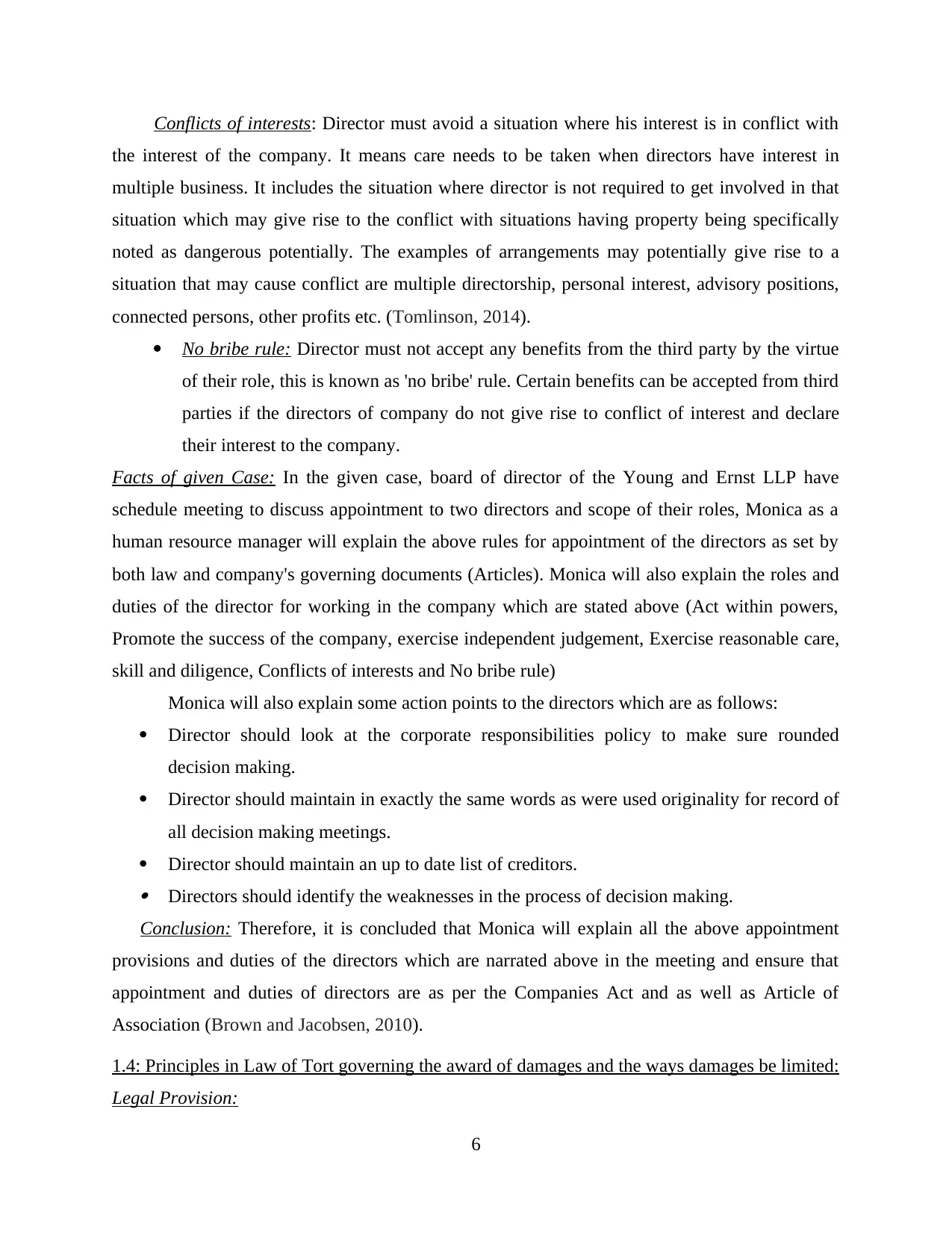
Conflicts of interests: Director must avoid a situation where his interest is in conflict with
the interest of the company. It means care needs to be taken when directors have interest in
multiple business. It includes the situation where director is not required to get involved in that
situation which may give rise to the conflict with situations having property being specifically
noted as dangerous potentially. The examples of arrangements may potentially give rise to a
situation that may cause conflict are multiple directorship, personal interest, advisory positions,
connected persons, other profits etc. (Tomlinson, 2014).
No bribe rule: Director must not accept any benefits from the third party by the virtue
of their role, this is known as 'no bribe' rule. Certain benefits can be accepted from third
parties if the directors of company do not give rise to conflict of interest and declare
their interest to the company.
Facts of given Case: In the given case, board of director of the Young and Ernst LLP have
schedule meeting to discuss appointment to two directors and scope of their roles, Monica as a
human resource manager will explain the above rules for appointment of the directors as set by
both law and company's governing documents (Articles). Monica will also explain the roles and
duties of the director for working in the company which are stated above (Act within powers,
Promote the success of the company, exercise independent judgement, Exercise reasonable care,
skill and diligence, Conflicts of interests and No bribe rule)
Monica will also explain some action points to the directors which are as follows:
Director should look at the corporate responsibilities policy to make sure rounded
decision making.
Director should maintain in exactly the same words as were used originality for record of
all decision making meetings.
Director should maintain an up to date list of creditors. Directors should identify the weaknesses in the process of decision making.
Conclusion: Therefore, it is concluded that Monica will explain all the above appointment
provisions and duties of the directors which are narrated above in the meeting and ensure that
appointment and duties of directors are as per the Companies Act and as well as Article of
Association (Brown and Jacobsen, 2010).
1.4: Principles in Law of Tort governing the award of damages and the ways damages be limited:
Legal Provision:
6
the interest of the company. It means care needs to be taken when directors have interest in
multiple business. It includes the situation where director is not required to get involved in that
situation which may give rise to the conflict with situations having property being specifically
noted as dangerous potentially. The examples of arrangements may potentially give rise to a
situation that may cause conflict are multiple directorship, personal interest, advisory positions,
connected persons, other profits etc. (Tomlinson, 2014).
No bribe rule: Director must not accept any benefits from the third party by the virtue
of their role, this is known as 'no bribe' rule. Certain benefits can be accepted from third
parties if the directors of company do not give rise to conflict of interest and declare
their interest to the company.
Facts of given Case: In the given case, board of director of the Young and Ernst LLP have
schedule meeting to discuss appointment to two directors and scope of their roles, Monica as a
human resource manager will explain the above rules for appointment of the directors as set by
both law and company's governing documents (Articles). Monica will also explain the roles and
duties of the director for working in the company which are stated above (Act within powers,
Promote the success of the company, exercise independent judgement, Exercise reasonable care,
skill and diligence, Conflicts of interests and No bribe rule)
Monica will also explain some action points to the directors which are as follows:
Director should look at the corporate responsibilities policy to make sure rounded
decision making.
Director should maintain in exactly the same words as were used originality for record of
all decision making meetings.
Director should maintain an up to date list of creditors. Directors should identify the weaknesses in the process of decision making.
Conclusion: Therefore, it is concluded that Monica will explain all the above appointment
provisions and duties of the directors which are narrated above in the meeting and ensure that
appointment and duties of directors are as per the Companies Act and as well as Article of
Association (Brown and Jacobsen, 2010).
1.4: Principles in Law of Tort governing the award of damages and the ways damages be limited:
Legal Provision:
6
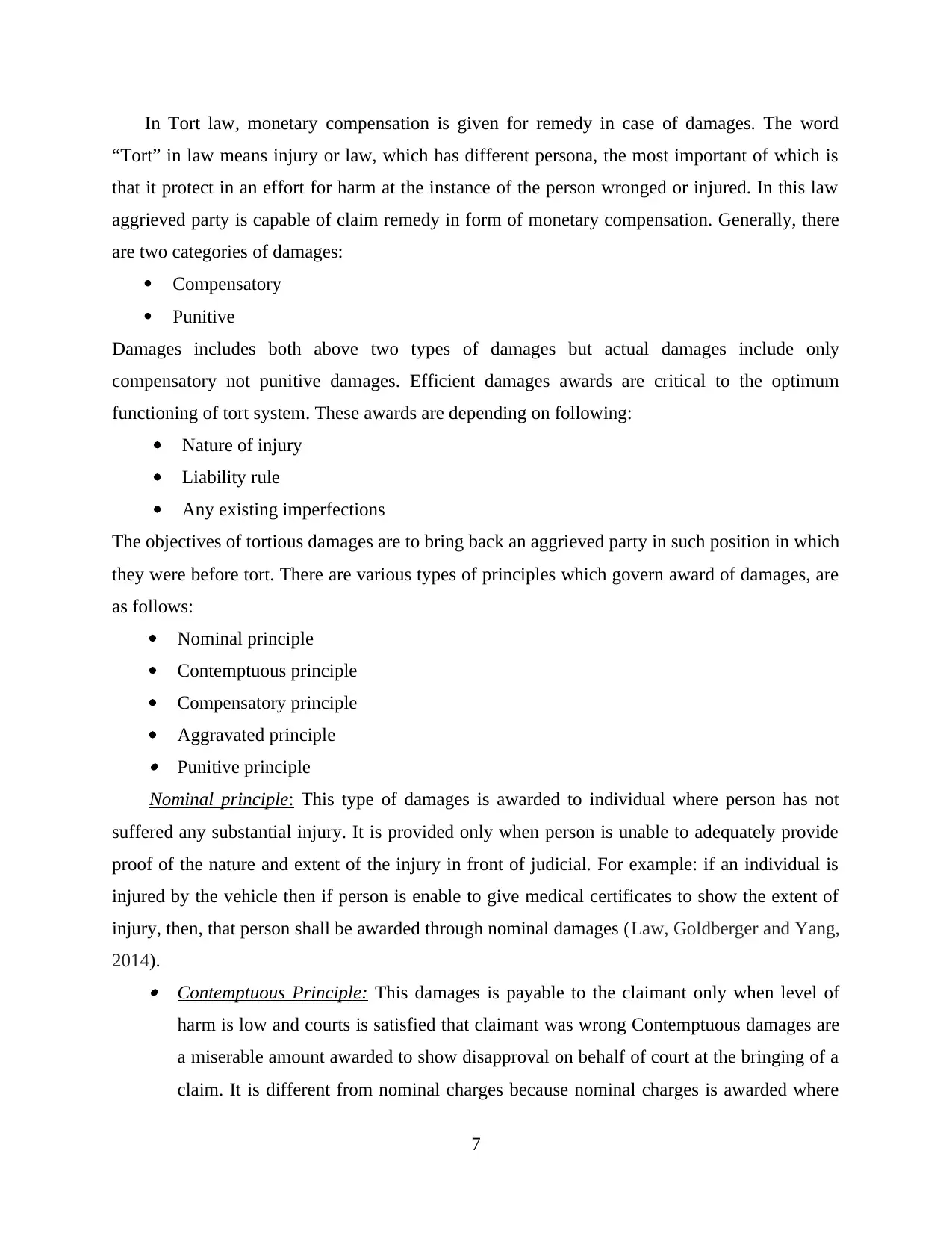
In Tort law, monetary compensation is given for remedy in case of damages. The word
“Tort” in law means injury or law, which has different persona, the most important of which is
that it protect in an effort for harm at the instance of the person wronged or injured. In this law
aggrieved party is capable of claim remedy in form of monetary compensation. Generally, there
are two categories of damages:
Compensatory
Punitive
Damages includes both above two types of damages but actual damages include only
compensatory not punitive damages. Efficient damages awards are critical to the optimum
functioning of tort system. These awards are depending on following:
Nature of injury
Liability rule
Any existing imperfections
The objectives of tortious damages are to bring back an aggrieved party in such position in which
they were before tort. There are various types of principles which govern award of damages, are
as follows:
Nominal principle
Contemptuous principle
Compensatory principle
Aggravated principle Punitive principle
Nominal principle: This type of damages is awarded to individual where person has not
suffered any substantial injury. It is provided only when person is unable to adequately provide
proof of the nature and extent of the injury in front of judicial. For example: if an individual is
injured by the vehicle then if person is enable to give medical certificates to show the extent of
injury, then, that person shall be awarded through nominal damages (Law, Goldberger and Yang,
2014). Contemptuous Principle: This damages is payable to the claimant only when level of
harm is low and courts is satisfied that claimant was wrong Contemptuous damages are
a miserable amount awarded to show disapproval on behalf of court at the bringing of a
claim. It is different from nominal charges because nominal charges is awarded where
7
“Tort” in law means injury or law, which has different persona, the most important of which is
that it protect in an effort for harm at the instance of the person wronged or injured. In this law
aggrieved party is capable of claim remedy in form of monetary compensation. Generally, there
are two categories of damages:
Compensatory
Punitive
Damages includes both above two types of damages but actual damages include only
compensatory not punitive damages. Efficient damages awards are critical to the optimum
functioning of tort system. These awards are depending on following:
Nature of injury
Liability rule
Any existing imperfections
The objectives of tortious damages are to bring back an aggrieved party in such position in which
they were before tort. There are various types of principles which govern award of damages, are
as follows:
Nominal principle
Contemptuous principle
Compensatory principle
Aggravated principle Punitive principle
Nominal principle: This type of damages is awarded to individual where person has not
suffered any substantial injury. It is provided only when person is unable to adequately provide
proof of the nature and extent of the injury in front of judicial. For example: if an individual is
injured by the vehicle then if person is enable to give medical certificates to show the extent of
injury, then, that person shall be awarded through nominal damages (Law, Goldberger and Yang,
2014). Contemptuous Principle: This damages is payable to the claimant only when level of
harm is low and courts is satisfied that claimant was wrong Contemptuous damages are
a miserable amount awarded to show disapproval on behalf of court at the bringing of a
claim. It is different from nominal charges because nominal charges is awarded where
7
⊘ This is a preview!⊘
Do you want full access?
Subscribe today to unlock all pages.

Trusted by 1+ million students worldwide
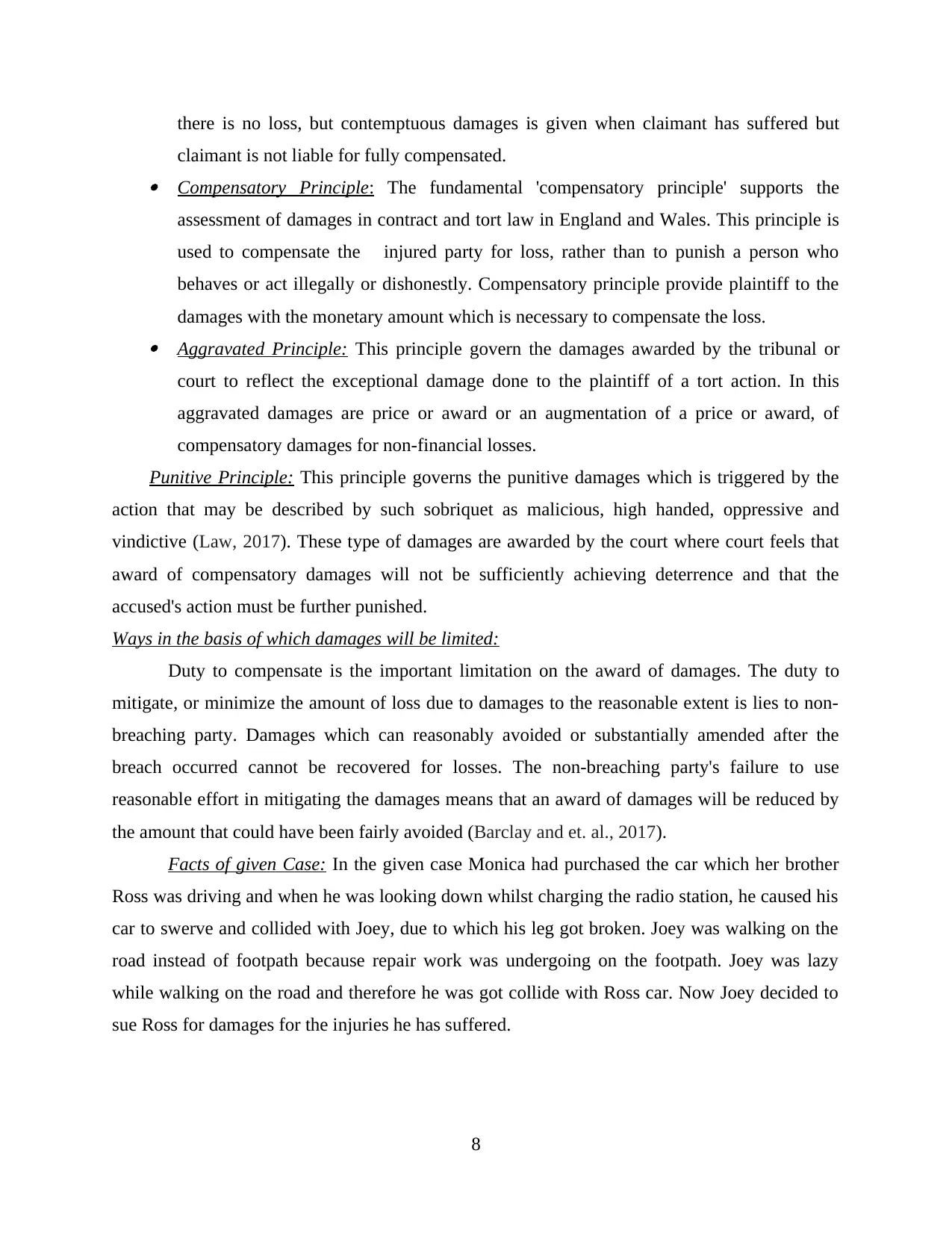
there is no loss, but contemptuous damages is given when claimant has suffered but
claimant is not liable for fully compensated. Compensatory Principle: The fundamental 'compensatory principle' supports the
assessment of damages in contract and tort law in England and Wales. This principle is
used to compensate the injured party for loss, rather than to punish a person who
behaves or act illegally or dishonestly. Compensatory principle provide plaintiff to the
damages with the monetary amount which is necessary to compensate the loss. Aggravated Principle: This principle govern the damages awarded by the tribunal or
court to reflect the exceptional damage done to the plaintiff of a tort action. In this
aggravated damages are price or award or an augmentation of a price or award, of
compensatory damages for non-financial losses.
Punitive Principle: This principle governs the punitive damages which is triggered by the
action that may be described by such sobriquet as malicious, high handed, oppressive and
vindictive (Law, 2017). These type of damages are awarded by the court where court feels that
award of compensatory damages will not be sufficiently achieving deterrence and that the
accused's action must be further punished.
Ways in the basis of which damages will be limited:
Duty to compensate is the important limitation on the award of damages. The duty to
mitigate, or minimize the amount of loss due to damages to the reasonable extent is lies to non-
breaching party. Damages which can reasonably avoided or substantially amended after the
breach occurred cannot be recovered for losses. The non-breaching party's failure to use
reasonable effort in mitigating the damages means that an award of damages will be reduced by
the amount that could have been fairly avoided (Barclay and et. al., 2017).
Facts of given Case: In the given case Monica had purchased the car which her brother
Ross was driving and when he was looking down whilst charging the radio station, he caused his
car to swerve and collided with Joey, due to which his leg got broken. Joey was walking on the
road instead of footpath because repair work was undergoing on the footpath. Joey was lazy
while walking on the road and therefore he was got collide with Ross car. Now Joey decided to
sue Ross for damages for the injuries he has suffered.
8
claimant is not liable for fully compensated. Compensatory Principle: The fundamental 'compensatory principle' supports the
assessment of damages in contract and tort law in England and Wales. This principle is
used to compensate the injured party for loss, rather than to punish a person who
behaves or act illegally or dishonestly. Compensatory principle provide plaintiff to the
damages with the monetary amount which is necessary to compensate the loss. Aggravated Principle: This principle govern the damages awarded by the tribunal or
court to reflect the exceptional damage done to the plaintiff of a tort action. In this
aggravated damages are price or award or an augmentation of a price or award, of
compensatory damages for non-financial losses.
Punitive Principle: This principle governs the punitive damages which is triggered by the
action that may be described by such sobriquet as malicious, high handed, oppressive and
vindictive (Law, 2017). These type of damages are awarded by the court where court feels that
award of compensatory damages will not be sufficiently achieving deterrence and that the
accused's action must be further punished.
Ways in the basis of which damages will be limited:
Duty to compensate is the important limitation on the award of damages. The duty to
mitigate, or minimize the amount of loss due to damages to the reasonable extent is lies to non-
breaching party. Damages which can reasonably avoided or substantially amended after the
breach occurred cannot be recovered for losses. The non-breaching party's failure to use
reasonable effort in mitigating the damages means that an award of damages will be reduced by
the amount that could have been fairly avoided (Barclay and et. al., 2017).
Facts of given Case: In the given case Monica had purchased the car which her brother
Ross was driving and when he was looking down whilst charging the radio station, he caused his
car to swerve and collided with Joey, due to which his leg got broken. Joey was walking on the
road instead of footpath because repair work was undergoing on the footpath. Joey was lazy
while walking on the road and therefore he was got collide with Ross car. Now Joey decided to
sue Ross for damages for the injuries he has suffered.
8
Paraphrase This Document
Need a fresh take? Get an instant paraphrase of this document with our AI Paraphraser
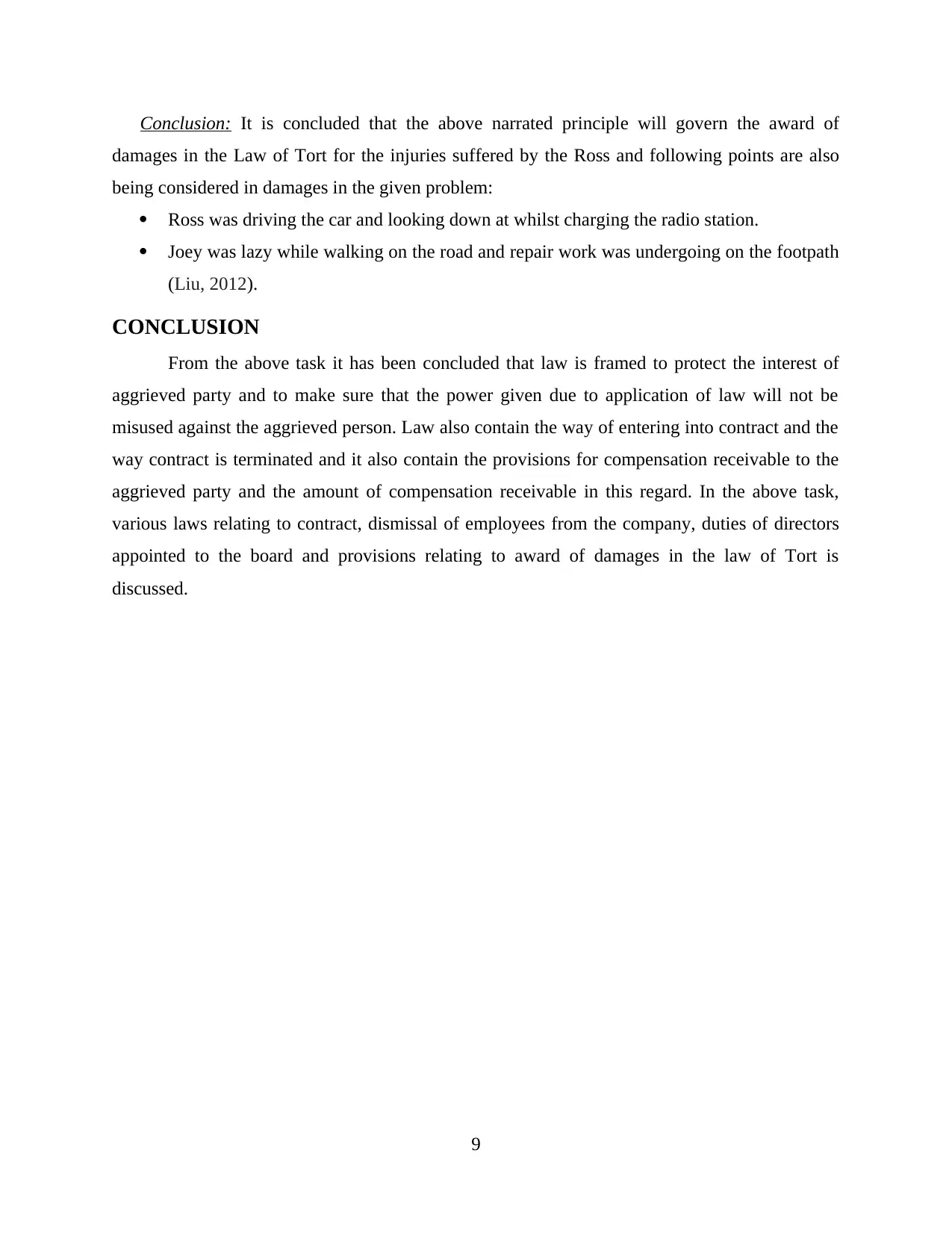
Conclusion: It is concluded that the above narrated principle will govern the award of
damages in the Law of Tort for the injuries suffered by the Ross and following points are also
being considered in damages in the given problem:
Ross was driving the car and looking down at whilst charging the radio station.
Joey was lazy while walking on the road and repair work was undergoing on the footpath
(Liu, 2012).
CONCLUSION
From the above task it has been concluded that law is framed to protect the interest of
aggrieved party and to make sure that the power given due to application of law will not be
misused against the aggrieved person. Law also contain the way of entering into contract and the
way contract is terminated and it also contain the provisions for compensation receivable to the
aggrieved party and the amount of compensation receivable in this regard. In the above task,
various laws relating to contract, dismissal of employees from the company, duties of directors
appointed to the board and provisions relating to award of damages in the law of Tort is
discussed.
9
damages in the Law of Tort for the injuries suffered by the Ross and following points are also
being considered in damages in the given problem:
Ross was driving the car and looking down at whilst charging the radio station.
Joey was lazy while walking on the road and repair work was undergoing on the footpath
(Liu, 2012).
CONCLUSION
From the above task it has been concluded that law is framed to protect the interest of
aggrieved party and to make sure that the power given due to application of law will not be
misused against the aggrieved person. Law also contain the way of entering into contract and the
way contract is terminated and it also contain the provisions for compensation receivable to the
aggrieved party and the amount of compensation receivable in this regard. In the above task,
various laws relating to contract, dismissal of employees from the company, duties of directors
appointed to the board and provisions relating to award of damages in the law of Tort is
discussed.
9
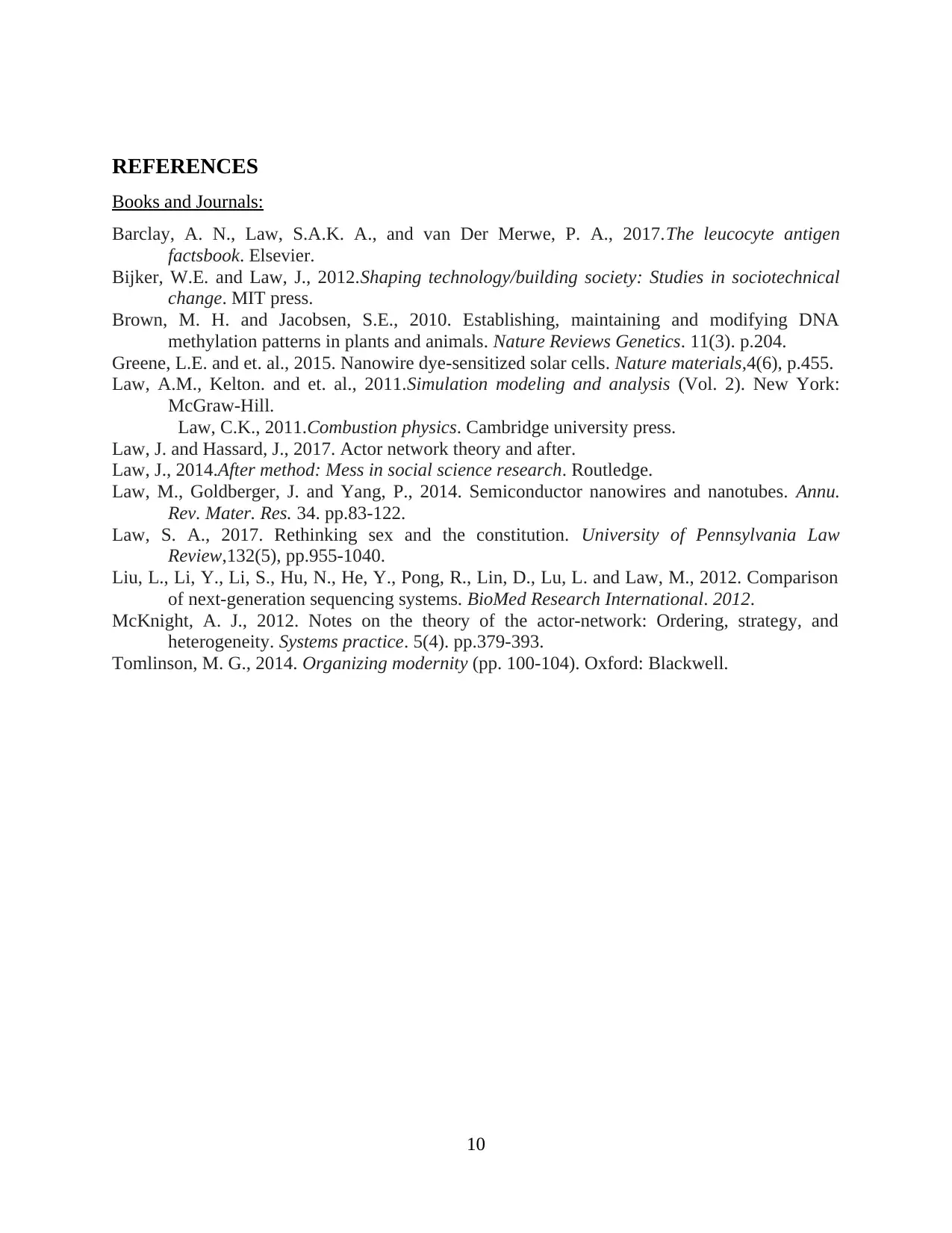
REFERENCES
Books and Journals:
Barclay, A. N., Law, S.A.K. A., and van Der Merwe, P. A., 2017.The leucocyte antigen
factsbook. Elsevier.
Bijker, W.E. and Law, J., 2012.Shaping technology/building society: Studies in sociotechnical
change. MIT press.
Brown, M. H. and Jacobsen, S.E., 2010. Establishing, maintaining and modifying DNA
methylation patterns in plants and animals. Nature Reviews Genetics. 11(3). p.204.
Greene, L.E. and et. al., 2015. Nanowire dye-sensitized solar cells. Nature materials,4(6), p.455.
Law, A.M., Kelton. and et. al., 2011.Simulation modeling and analysis (Vol. 2). New York:
McGraw-Hill.
Law, C.K., 2011.Combustion physics. Cambridge university press.
Law, J. and Hassard, J., 2017. Actor network theory and after.
Law, J., 2014.After method: Mess in social science research. Routledge.
Law, M., Goldberger, J. and Yang, P., 2014. Semiconductor nanowires and nanotubes. Annu.
Rev. Mater. Res. 34. pp.83-122.
Law, S. A., 2017. Rethinking sex and the constitution. University of Pennsylvania Law
Review,132(5), pp.955-1040.
Liu, L., Li, Y., Li, S., Hu, N., He, Y., Pong, R., Lin, D., Lu, L. and Law, M., 2012. Comparison
of next-generation sequencing systems. BioMed Research International. 2012.
McKnight, A. J., 2012. Notes on the theory of the actor-network: Ordering, strategy, and
heterogeneity. Systems practice. 5(4). pp.379-393.
Tomlinson, M. G., 2014. Organizing modernity (pp. 100-104). Oxford: Blackwell.
10
Books and Journals:
Barclay, A. N., Law, S.A.K. A., and van Der Merwe, P. A., 2017.The leucocyte antigen
factsbook. Elsevier.
Bijker, W.E. and Law, J., 2012.Shaping technology/building society: Studies in sociotechnical
change. MIT press.
Brown, M. H. and Jacobsen, S.E., 2010. Establishing, maintaining and modifying DNA
methylation patterns in plants and animals. Nature Reviews Genetics. 11(3). p.204.
Greene, L.E. and et. al., 2015. Nanowire dye-sensitized solar cells. Nature materials,4(6), p.455.
Law, A.M., Kelton. and et. al., 2011.Simulation modeling and analysis (Vol. 2). New York:
McGraw-Hill.
Law, C.K., 2011.Combustion physics. Cambridge university press.
Law, J. and Hassard, J., 2017. Actor network theory and after.
Law, J., 2014.After method: Mess in social science research. Routledge.
Law, M., Goldberger, J. and Yang, P., 2014. Semiconductor nanowires and nanotubes. Annu.
Rev. Mater. Res. 34. pp.83-122.
Law, S. A., 2017. Rethinking sex and the constitution. University of Pennsylvania Law
Review,132(5), pp.955-1040.
Liu, L., Li, Y., Li, S., Hu, N., He, Y., Pong, R., Lin, D., Lu, L. and Law, M., 2012. Comparison
of next-generation sequencing systems. BioMed Research International. 2012.
McKnight, A. J., 2012. Notes on the theory of the actor-network: Ordering, strategy, and
heterogeneity. Systems practice. 5(4). pp.379-393.
Tomlinson, M. G., 2014. Organizing modernity (pp. 100-104). Oxford: Blackwell.
10
⊘ This is a preview!⊘
Do you want full access?
Subscribe today to unlock all pages.

Trusted by 1+ million students worldwide
1 out of 12
Related Documents
Your All-in-One AI-Powered Toolkit for Academic Success.
+13062052269
info@desklib.com
Available 24*7 on WhatsApp / Email
![[object Object]](/_next/static/media/star-bottom.7253800d.svg)
Unlock your academic potential
© 2024 | Zucol Services PVT LTD | All rights reserved.





